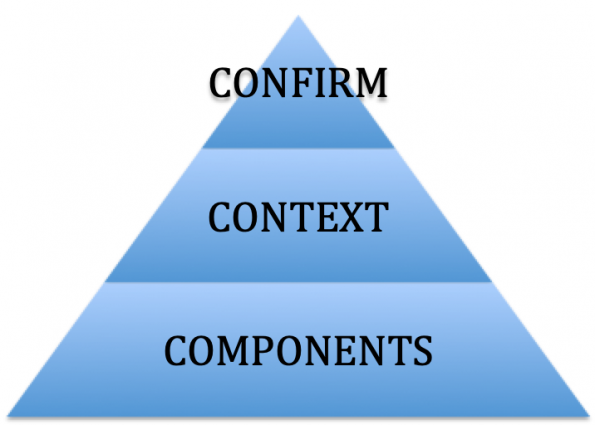Structuring interview answers
Most good interviews use behavioural based interview questions. These are questions that can take the form “can you tell me about a time when…” though the specific wording can change. It is an easy yet powerful technique to structure the response to these questions with my 3C pyramid:

This approach quickly confirms you have interpreted the question correctly, orientates the interviewers to specifics of the context, and builds the detail to ensure you deliver enough content while minimising time spent to maximise the time for other questions. If you are prone to your mind wondering and going off on a tangent this also helps to keep you focused
Confirm
The first sentence of the response to a behavioural interview question should be a confirmation you have done the required thing.
Interviewer: Can you tell me about a time when you have performed a miracle.
Candidate: I devised and implemented a competition legal walking on water approach for the swim section of the inter-department triathlon. This led to our victory for the first time in the divisions’ history.
This immediately confirms to the interviewer that you have understood the question and gives them a chance to interject if you are starting on the wrong foot. In business, some words can mean very different things in different contexts so that is a valuable safety net.
Starting with this newspaper headline approach reduces the cognitive load on the interviewer as they now know where the story is going. They don’t need to process 5 minutes of triathlon talk wondering why this is relevant to discover at the end you walked on water. With the storytelling approach, the interviewer needs to mentally rewind the whole conversation to evaluate the strength of the answer.
Context
If confirm is the newspaper headline, context is the first paragraph. This part of the answer orientates the interviewer to the complexities of the challenge you undertook. It provides the interviewer with a context within which they can evaluate your response.
C: In my role as assistant to the head of engineering I was required to devise and implement a strategy to walk on water so that we could improve our performance in the interdepartmental triathlon. We had always scored in the bottom quartile and this was damaging our reputation as a high performing team. Additionally is we beat the Marketing Department the VP of marketing would cover the marketing overtime needed to launch the new gizmo on time.
Components
This is the meat of the interview answer. It groups all the things you did into a set of components with a justification. Many people have interview answers that take the form I did this and then I did this and then… which leaves the interviewer to do all the hard work. The interviewer is trying to assess if you can solve similar problems for them. Therefore the goal is to answer with a set of repeatable components.
C: To achieve this I broke my work into 3 main elements. These were: research, approach selection, and practice.
The research was required to inform the approach selection. The key facts needed for this was understanding what techniques would be competition legal and the required swim time to beet marketing.
Approach selection evaluated the potential approached used a weighted analysis technique to rank order the possible approaches.
My intent for the practice elements was to hone my skills in the chosen technique to give me the best chance on race day. However, when my performance did not improve as expected I additionally experimented with the two other top scoring techniques. It was the third scoring approach that I was able to display most proficiency with. This highlighted there were individualised factors missing from the analysis. To combat this in the future I would plan to iterate between selection and practice.
Through this, I was able to cut 40% of our “swim” time, moving our department up to a top 10 finisher for the triathlon and crucially beating marketing.
Would you like me to go into any more detail on and the activities in each element?
The last sentence is a powerful one because the interviewer might want more detail to satisfy their requirements. If they don’t want more detail you get to save time. Without a structured approach, it’s easy to spend 10 minutes describing an elaborate weighted analysis approach when that’s not what they are looking for.
Conclusions
Structuring answers to interview questions provides a framework to help keep different thinkers on track in a stressful situation. The 3C approach is a powerful structuring technique (and one you don’t have to save just for interviews)

